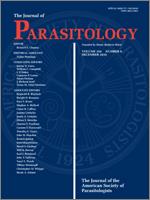Diagnosis of parasitic diseases that involve tissue-stage larvae is challenging, and serology remains the most effective antemortem test for detecting these infections. Baylisascaris procyonis, the raccoon roundworm, is a zoonotic ascarid. Raccoons are the usual definitive host, and humans may be infected as accidental hosts. More than 150 species of birds and mammals may act as paratenic hosts, and rodents play an important role in the transmission and maintenance of this parasite in nature. Migratory larvae in paratenic host tissues can produce ocular disease and severe to fatal neurologic disease, but not all infected hosts develop signs. A sensitive and specific Western blot (WB) assay based on a recombinant Baylisascaris-specific antigen (rBpRAG-1) has been developed for use in humans. We evaluated the use of this antigen to detect Baylisascaris spp. infections in rodent paratenic hosts. With the use of 4 species of Peromyscus mice (Peromyscus californicus, Peromyscus leucopus, Peromyscus maniculatus, Peromyscus polionotus) from a previous infection trial, we developed species-adapted WB and ELISA assays and evaluated performance compared to detection of larvae in tissue samples. These assays revealed species-level differences in seroconversion and terminal antibody concentrations, with P. leucopus developing significantly greater antibody concentrations than P. californicus and P. polionotus at all dose levels, and P. maniculatus at the low dose. Some P. californicus and P. polionotus failed to seroconvert despite the recovery of larvae from their tissues. WB and ELISA results were correlated; however, the WB demonstrated higher sensitivity than the ELISA overall (72.2% versus 63.9%, respectively). With the use of experimental samples, specificity was 100% for WB and 94.1% for ELISA. A WB was also used to test Mus and Rattus samples, and although numbers were too limited to evaluate sensitivity and specificity, all animals known to be infected by tissue digestion were WB positive, and all uninfected animals were negative. Finally, the Peromyscus-adapted WB and ELISA were used to test a set of serum samples from wild-trapped P. maniculatus and Rattus rattus. Both assays were generally sensitive, but specificity was equivocal. This emphasizes the challenge of using serology for investigation of wildlife diseases, in which hosts have unknown exposure histories. Nevertheless, serologic methods have utility in the study of Baylisascaris spp. in paratenic hosts, either wild or captive, and have advantageous attributes (non-lethal, high-throughput), but results should be interpreted carefully.
How to translate text using browser tools
1 December 2018
Detection and Evaluation of Antibody Response to a Baylisascaris-Specific Antigen in Rodent Hosts with the Use of Western Blotting and Elisa
Sarah G. H. Sapp,
Sukwan Handali,
Sara B. Weinstein,
Michael J. Yabsley
ACCESS THE FULL ARTICLE

Journal of Parasitology
Vol. 104 • No. 6
December 2018
Vol. 104 • No. 6
December 2018




